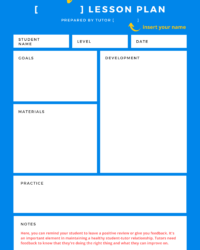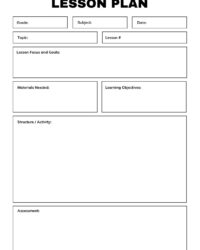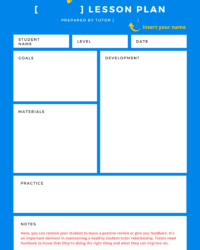Ever felt like your lessons, despite all your hard work, sometimes lack that sharp edge or clear direction for your students? It is a common experience in the dynamic world of education. Teachers pour their hearts into preparing, but sometimes the core objective, the true ‘learning focus,’ can get diluted amidst all the activities and content. Imagine a tool that helps you pinpoint exactly what students should grasp by the end of a session, making every minute count.
That is where the power of a dedicated learning focus lesson plan template comes into play. It is not just another piece of paperwork; it is a strategic framework designed to bring unparalleled clarity and intentionality to your teaching. By centering your planning around the specific learning outcomes, you create a pathway that guides both your instruction and your students’ journey, ensuring meaningful engagement and deeper understanding. Let us explore how this approach can transform your classroom.
Why a Learning Focus Matters in Every Lesson
Understanding the Core of Learning Focus
At its heart, a learning focus is the specific, measurable, and observable learning outcome you intend for your students to achieve by the end of a lesson. It is the answer to the question: “What will students be able to do or understand as a result of this lesson?” Without this clear focus, lessons can become a collection of activities rather than a purposeful progression towards knowledge acquisition or skill development. Think of it as the North Star for your educational voyage, guiding every step from introduction to assessment.
Benefits for Students and Teachers Alike
When lessons are driven by a strong learning focus, the benefits ripple through the entire learning environment. For students, it provides clarity. They know what is expected of them, which helps them direct their attention, participate more meaningfully, and self-regulate their learning. This transparency reduces anxiety and increases motivation, as they can see the purpose behind each activity. It also empowers them to take ownership of their learning, becoming active participants rather than passive recipients.
For educators, a defined learning focus simplifies the planning process. It helps in selecting relevant materials, designing appropriate activities, and crafting effective assessment strategies that directly measure whether the intended learning has occurred. It streamlines classroom management by keeping both teacher and students aligned on the goal, minimizing tangents and maximizing instructional time. Moreover, it makes differentiating instruction much easier, as you can tailor support to help all learners reach the same core objective.
Elements of a Powerful Learning Focus
A truly effective learning focus is more than just a topic. It is precise, actionable, and student-centered. Here are some key characteristics to aim for when formulating your focus:
- Specificity: Avoid vague statements like “students will learn about science.” Instead, specify what about science they will learn, e.g., “students will be able to explain the water cycle.”
- Measurability: Can you observe or assess if students have achieved it? Use action verbs like “analyze,” “compare,” “create,” “evaluate,” “identify,” or “solve.”
- Attainability: Is it realistic for students to achieve this within the given lesson time and with their current prior knowledge?
- Relevance: Does it connect to broader curriculum goals or real-world applications?
- Time-bound: Is it clearly defined for a single lesson or a short sequence?
Avoiding Common Pitfalls
Even with the best intentions, it is easy to stumble when defining your learning focus. One common mistake is confusing activities with outcomes. For instance, “students will complete a worksheet” is an activity, not a learning focus. The focus should be what they learn by completing the worksheet. Another pitfall is having too many focuses for one lesson, which can overwhelm both you and your students. Stick to one or two clear, impactful objectives per session to maintain clarity and depth.
Crafting Your Own Learning Focus Lesson Plan Template
Now that we understand the immense value of a learning focus, how do we translate that understanding into a practical, reusable tool? Developing your own learning focus lesson plan template is a game-changer for consistency and efficiency in your teaching. It provides a structured approach that ensures every lesson is purposeful, building upon previous learning and preparing students for future challenges. Think of it as your personal blueprint for educational success, adaptable to any subject or grade level.
The beauty of creating your own template lies in its customizability. You can design it to reflect your teaching style, your school’s requirements, and the unique needs of your students. While there are many pre-made templates available, building one from scratch, or significantly modifying an existing one, deepens your understanding of its components and reinforces your commitment to focused instruction. It is an investment in your professional development that pays dividends in student achievement and your own peace of mind.
Here are some essential elements and steps to consider when constructing your robust learning focus lesson plan template:
- Lesson Title and Subject: Basic identification for quick reference.
- Grade Level and Time Allotment: Helps in planning appropriate content and pacing.
- Primary Learning Focus/Objective: This is the heart of your plan. State it clearly using action verbs and specifying what students will know or be able to do.
- Prior Knowledge/Prerequisites: What should students already understand to engage with this lesson successfully?
- Materials Needed: A comprehensive list of resources, technology, handouts, etc.
- Lesson Procedure (Sequential Steps):
- Engage/Hook: How will you capture students’ attention and activate prior knowledge?
- Explore/Direct Instruction: How will you deliver the content or facilitate discovery?
- Explain/Elaborate: How will students deepen their understanding or practice the skill?
- Evaluate/Assess: How will you check for understanding against the learning focus?
- Differentiation Strategies: How will you support struggling learners and challenge advanced ones?
- Assessment Methods: Formative and summative checks to measure the learning focus.
- Reflection/Notes for Next Time: What worked? What could be improved? This is crucial for continuous improvement.
Embracing a systematic approach to lesson planning, especially one centered around a clear learning focus, is arguably one of the most impactful strategies any educator can adopt. It transforms teaching from a series of tasks into a purposeful journey, ensuring that every moment in the classroom contributes directly to measurable student growth. By consistently using a well-designed template, you cultivate a teaching practice that is not only highly effective but also deeply rewarding, seeing your students achieve exactly what you set out to teach.
The commitment to defining and prioritizing learning outcomes empowers you to create dynamic, engaging, and highly successful learning environments. It is a powerful tool for clarity, efficiency, and ultimately, for fostering truly meaningful educational experiences for everyone involved. As you continue to refine your craft, remember that the most effective lessons are those built on a foundation of crystal-clear intent and a strong vision for student accomplishment.


